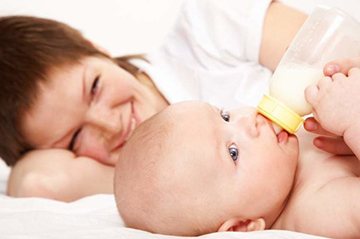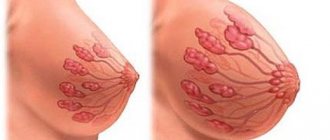Breastfeeding is an important physical and emotional process that connects mother and baby.
The child grows, and the composition of milk and the function of breastfeeding change along with it.
But a period inevitably comes when, for one reason or another, attachments need to be stopped, and then the woman is faced with the question of how to do this as painlessly as possible, without causing stress to the child.
What is the best way to wean a two year old?
The World Health Organization recommends breastfeeding until at least two years of age.
After a year, a large amount of antibodies and immunoglobulins are formed in mother’s milk, which protect the baby’s body from the effects of negative environmental factors.
Thanks to natural protection, any baby’s illnesses occur in a milder form and drug intervention is much less likely to be required.
In addition, the daily dose of milk for a child over two years old, according to average data, satisfies the need for:
- protein – by 43%;
- calcium – 36%;
- vitamin A – 45%;
- vitamin B – 94%;
- vitamin C – 60%;
- folic acid – 76%.
Pediatricians and lactation consultants say that breastfeeding for up to two years and longer reduces the risk of developing such terrible diseases as cancer, diabetes, and atherosclerosis. It also reduces the risk of allergic reactions and their development in later life.
In addition to the obvious physical benefits, breastfeeding also has a positive effect on the baby’s mental abilities. Scientists found that children who were breastfed until they were two years old and older had better academic performance among their peers. It is also noted that they went through the period of social adaptation more calmly and were more confident in themselves. Even at the age of two, these children were able to show the best results in speech development.
When is it time to wean your baby?
As the child grows, pediatricians determine the time for introducing additional foods into the diet. A standard scheme for introducing complementary foods has been developed. The decision to change the diet is made by the doctor together with the mother. Natural weaning occurs as breast milk is replaced with other foods.
In any option of weaning from breastfeeding, except in emergency cases, the process will be delayed. Not a single pediatrician will say as an order “tomorrow we will wean!” This decision is made by the mother. Feeding can last up to three to four years. Do not forget that the process of lactation is used as a contraceptive. The hormone prolactin can suppress ovulation in a woman’s body.

Today, social factors come to the fore: going to work, changing place of residence, changing social living conditions. They push to the decision to refuse feeding.
Pediatricians insist on feeding the baby up to one year. This is good for the health of both mother and baby. But there are women who decide to extend the feeding period.
Rules for weaning after 1 year.
When such a decision is made, be in a positive mood with the whole family. Mother and baby will need the support of others. Even if all recommendations are followed, weaning from breastfeeding will take place according to the child’s personal schedule.
- Parents must time the process to begin. Analyze factors: time of year, family situation, child’s health status. This should not be a period with sudden changes in temperature and atmospheric pressure. No moving or financial turmoil. The emotional instability of the mother will affect the condition of the child
- For a one-year-old baby, replace one feeding with bottle feeding or water.

- You cannot begin weaning by eliminating night or morning milk intake. Doctors advise giving them up as a last resort.
- Psychologists advise, as an option for weaning from breastfeeding, an “emotional replacement for milk.” A baby at this age already consciously eats. Introduce additional psychological elements into practice. For example, tell a story before bed, then breastfeed. After frequently performing the “going to bed” ritual, it will be possible to eliminate one element - breastfeeding.
- The child perceives his mother’s breast in his own way. It is not recommended to wear an open neckline or change clothes in front of a child. It is advisable to change the smell and clothes during this period so as not to provoke the child’s subconscious to suck.
- One feeding a day can be done by dad or grandma. Relatives are people familiar to the baby’s psyche, but their appearance and smell do not provoke the instinct to suck.
Tip: Don't set specific deadlines or dates. A child is not a clockwork mechanism. Even if everything goes smoothly and according to plan, at any moment the baby can change the course of things. Then change your plans and adapt to his desires.
Rules for weaning after two years
Not all mothers breastfeed until this age. And when weaning two-year-olds, there are peculiarities of a psychological and emotional nature. The child is already eating “adult” food and is ready for social adaptation.
Children at this age need communication with peers. But some people cannot refuse mother’s milk on their own and resist weaning on their mother’s initiative. Not because it is vitally necessary for the body, it has become a habit. The child does not understand why he should do this.
- Persuasion or games are a way for two-year-old children to distract themselves from breastfeeding. Not all children, due to their temperament, are able to listen to explanations. Create a fun game. For example, when a child wants to latch on to the breast, he will offer him food along with a toy. It is better if the father or older child acts as a toy. Three characters will participate in the eating process, and the child’s attention will switch to a new process. And when feeding is over, the baby will be full and will forget about sucking at the breast.
- A method of replacing breast milk with a bottle. This will not add rest to the mother, but will give children who are psychologically dependent on night feedings the necessary sucking process. Pediatricians insist that it is better to replace night feedings with a bottle of warm water. If you use a mixture or water with sugar, it will cause tooth decay.
- Change the scenery - a way of external change. Temporarily move the baby, for example, to a grandmother or friend. The new interior will occupy his attention; there is nothing there that reminds him of his mother’s breast. Take him to his usual surroundings at night, home.

- Make milk taste bad. For two-year-olds, breast milk is not the main food; if you make the taste of milk unpleasant, the baby himself will refuse to suck. Doctors recommend natural ingredients - garlic, motherwort, hawthorn. Their use makes the milk bitter, but safe for the baby’s health.
Benefits for maternal health

Scientists conducted work in thirty countries around the world, and it was found that breastfeeding for up to a year reduces the risk of breast cancer by 32%, and each subsequent year by 19%.
The processes of breast milk secretion reduce the level of estrogen and prolactin in the blood. The less of these hormones, the less the cells of the gland ducts divide and the less likely it is to form a tumor.
Breastfeeding is a preventive measure against stress. The emotional state of nursing mothers is more stable; they are able to rest and relax during feeding, which contributes to additional bonding between mother and child. Such women are more likely to have a good mood and less likely to experience depression.
Common Misconceptions

Society reacts differently to long-term feeding of children.
You often have to deal with inappropriate remarks and accusations.
Usually they have no basis in reality.
The most common of them: the baby has little interest in adult food; early caries; pathological dependence on mother; The older the child, the more difficult it is to wean.
There is an opinion that if a child eats little, then breastfeeding should be stopped. Contrary to this statement, it very often happens that the mother stops feeding, and the child never develops interest in adult food. The reasons for this behavior must be sought in the principles of introducing complementary foods or in heredity. If the child is cheerful and does not have developmental disabilities, then everything is in order; you should wait until interest manifests itself.
Early caries also has nothing to do with long-term breastfeeding. Milk does not affect the acid-base balance of the oral cavity, and some of its components serve as caries prevention.
And others like to blame long-term breastfeeding for pathological dependence on mother. Of course, this statement is false. The reason for this behavior is the incorrect building of the relationship between mother and baby. In order not to make a little tyrant out of your child, you need to promptly determine the boundaries of permitted and unacceptable behavior.
It is a huge misconception that the older the child, the more difficult it is to wean him off the breast. There is such a thing as the natural end of breastfeeding. This usually occurs between three and four years of age. During this period, and it may differ from child to child, the child himself refuses to suck.
So, if a woman has weighed all the factors and realized that the time has come, she needs to be patient, persistent and have a supply of little tricks.
Entertainment for kids

If we analyze the reasons why a child requires breastfeeding after two years, we can identify the main ones: when falling asleep; after waking up; to calm down; if you're bored.
The latter is easiest to minimize; the main thing is to always have some kind of “distraction” on hand that can captivate the child with play.
You need to stock up on such ideas in advance. The main thing is to participate fully in these games, involved, together with your baby, so that he feels your interest.
Method “1000 kisses”
Skin contact plays a huge role in the formation of a trusting relationship between mother and child. To prevent the child from taking weaning as a sign that the mother has begun to love him less, it is important to show your love for the baby as much as possible. Hugging, stroking, kissing, holding, talking about your feelings more often. It is impossible to spoil a baby with love.
Favorite Products

Even the biggest picky eater has his own set of favorite products.
They will be excellent assistants in the intended mission.
A good practice would be to delight your child with something tasty every day and involve him in the process of preparing these dishes to stir up interest.
Drinking for a child
The child must be able to satisfy his need to drink in a timely manner and independently. First of all, you need to organize a convenient place where there will always be a glass or sippy cup with clean water. If a child likes juices or compotes, it is also better to keep them in a place accessible to him.
How to recognize involution
Before you start weaning, you need to make sure that lactation is at its completion stage. This can be recognized by certain signs.
- Duration of breastfeeding. Involution usually occurs by 2.5 years. The earliest date is one year and 3 months. If this period coincides with the second pregnancy, most likely the milk will run out by the 5th month.
- Sucking activity. Intuitively, the baby tries to increase the amount of milk produced by frequent feeding, although recently he asked for the breast less often.
- During breaks between feedings of more than 12 hours, there is no feeling of fullness or pain in the chest.
- Mom's well-being. Often after feeding, women feel tired, drowsy, and pain around the nipples. In rare cases, even migraine attacks and fainting are possible.
Having noticed signs of impending involution, do not rush to immediately wean the baby from the breast, because... It is at this time that immunoglobulins are actively produced, which will protect the child from diseases.
At what point should you not start weaning?
There are unfavorable periods for weaning a child. It is better to take them into account in order to minimize the manifestations of stress and avoid consequences:

- Since breast milk is a natural source of beneficial components for children's immunity, you should not stop feeding during or immediately after illness. And also during an epidemic of viral diseases.
- It is not recommended to choose a hot summer period. At this time, the risk of intestinal infections increases.
- It is also better to wait out teething and the period of developmental leaps.
- Stressful situations associated with changes in the usual way of life of the family and the baby. Moving to a new place, the mother going to work, getting used to kindergarten and much more should be taken into account when planning the end of breastfeeding.
- Cessation of lactation before the onset of involution in a woman will lead to problems with excess milk and the formation of lumps.
Excommunication according to Komarovsky
Many mothers listen to the advice of the famous pediatrician Evgeniy Komarovsky. In his opinion, the main problem a woman will have to face is in her head. It is the mother who must be one hundred percent aware of her readiness and gain confidence in her decision. The child will easily adapt to circumstances and accept new rules.
The doctor's recommendations are as follows:
- a woman should drink less fluid;
- stop pumping;
- stop night feedings;
- increase physical activity, play sports;
- distract the child from feeding;
- influence the taste of milk by consuming strong-smelling foods.
Komarovsky believes that it is necessary to breastfeed a child for up to a year, and it is worth continuing only if this does not interfere with the woman’s realization in the social sphere.
How to wean your baby at night
How to wean your child off nighttime breastfeeding after one year, but continue breastfeeding until two years of age. There is no need to force weaning. By the age of one year, the frequency of such feedings decreases on its own. Only in rare cases, especially demanding children, do not want to change their eating habits.
- Cleaning up breastfeeding before bed should be the last thing you do. Having received the necessary supply of food and positive emotions, a one-year-old child is able to sleep most of the night, or even all night, without breastfeeding. Proper introduction of additional complementary foods and an active lifestyle during the day can give the child time at night to recuperate.
- Begin the weaning process by eliminating night feedings. During the day, the child is captivated by games and does not require breastfeeding; he will make up for lost food at night. Reduce the daily amount of milk, preferably reducing night feedings. During the day, it is worth reminding him about the breast on his own so that he receives the necessary nutrition.
- Feed your baby before you go to bed. Even if the baby is snoring cutely and you don’t want to disturb him, you need to gently wake him up and feed him. Otherwise, in an hour or two he will remind himself. Such feeding, not according to plan, will give the baby the necessary supply of milk, and the mother a chance to sleep until the morning.
- Introduce sleep rituals. Rocking in your arms, dad can do it. Light massage of the back and legs, like stroking. Subdued soft light. In the child’s mind, all these manipulations should be firmly attached to falling asleep.

Cradling in your arms is one of the methods for weaning your baby off breastfeeding at night. - If a child slept with his mother before this age, you need to gradually teach him to sleep separately. Start with naps during the day so that your baby gets used to his crib. At night, transfer it there after falling asleep. This will remove the mother, with her smell and breasts, from the child’s field of touch.
- If it is not possible to sleep separately or the baby actively resists this, increase the distance between the body of the mother and the child during sleep . Every day, move further and further within the same bed. So the baby stops feeling the smell and warmth from the mother’s body.
- Move feeding before bedtime to another place. For example, move to a chair or move to another room. Gradually form the concept in the child’s mind that the bed is a place for sleeping, and not for eating.
- For some children, the “replacement” principle works. After heavy feeding before bedtime, exclude the mother from the process of putting her to bed. Dad or grandmother can come as a replacement. The bedtime ritual will not be performed by the mother, but by another loved one. Psychologically, all the attributes of daily falling asleep will be observed, only the “mother factor”, which the baby firmly associates with food, will be removed.










